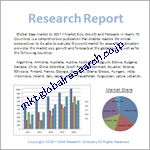目次
第1章 拡張現実ナビゲーションの世界市場世界の拡張現実ナビゲーション市場 エグゼクティブサマリー
1.1.拡張現実ナビゲーションの世界市場規模・予測(2022〜2032年)
1.2.地域別概要
1.3.セグメント別概要
1.3.1.製品別
1.3.2.用途別
1.4.主要トレンド
1.5.不況の影響
1.6.アナリストの提言と結論
第2章 拡張現実ナビゲーション世界の拡張現実ナビゲーション市場の定義と調査前提
2.1.調査目的
2.2.市場の定義
2.3.調査の前提
2.3.1.包含と除外
2.3.2.限界
2.3.3.供給サイドの分析
2.3.3.1.入手可能性
2.3.3.2.インフラ
2.3.3.3.規制環境
2.3.4.需要サイド分析
2.3.4.1.消費者の認識と受容
2.3.4.2.技術の進歩
2.4.推定方法
2.5.調査対象年
2.6.通貨換算レート
第3章.拡張現実ナビゲーションの世界市場ダイナミクス
3.1.市場促進要因
3.1.1.リアルタイム位置追跡のためのAIの採用
3.1.2.コネクテッドカーと自律走行車の成長
3.1.3.都市ナビゲーション・ソリューションに対する需要の高まり
3.2.市場の課題
3.2.1.GPSとセンサーの精度への依存
3.2.2.限られたユーザーへの親近感と受容性
3.3.市場機会
3.3.1.5G技術との統合
3.3.2.新興国での拡大
第4章.世界の拡張現実ナビゲーション市場産業分析
4.1.ポーターの5フォースモデル
4.1.1.サプライヤーの交渉力
4.1.2.バイヤーの交渉力
4.1.3.新規参入者の脅威
4.1.4.代替品の脅威
4.1.5.競合他社との競争
4.2.PESTEL分析
4.2.1.政治的
4.2.2.経済的
4.2.3.社会的
4.2.4.技術的
4.2.5.環境
4.2.6.法律
4.3.主な投資機会
4.4.トップ勝ち組戦略
第5章 拡張現実ナビゲーション拡張現実ナビゲーションの世界市場規模&予測:オファリング別2022~2032年
5.1.セグメントダッシュボード
5.2.HMD
5.3.HUD
5.4.ARナビゲーションソフトウェア
第6章 拡張現実ナビゲーション拡張現実ナビゲーションの世界市場規模・用途別予測 2022-2032
6.1.セグメントダッシュボード
6.2.リアルタイム位置情報管理
6.3.ルーティングとナビゲーション
6.4.資産追跡
6.5.逆ジオコーディング
第7章 拡張現実ナビゲーション拡張現実ナビゲーションの世界市場規模・地域別予測 2022-2032
7.1.北米
7.1.1.米国
7.1.2.カナダ
7.2.ヨーロッパ
7.2.1.英国
7.2.2.ドイツ
7.2.3.フランス
7.2.4.スペイン
7.2.5.イタリア
7.3.アジア太平洋
7.3.1.中国
7.3.2.インド
7.3.3.日本
7.3.4.オーストラリア
7.3.5.韓国
7.4.ラテンアメリカ
7.4.1.ブラジル
7.4.2.メキシコ
7.5.中東・アフリカ
7.5.1.サウジアラビア
7.5.2.南アフリカ
第8章 競争力コンペティティブ・インテリジェンス
8.1.主要企業のSWOT分析
8.1.1.グーグル合同会社
8.1.2.アップル
8.1.3.マイクロソフト
8.2.トップ市場戦略
8.3.企業プロフィール
第9章.調査プロセス
9.1.調査プロセス
9.1.1.データマイニング
9.1.2.分析
9.1.3.市場推定
9.1.4.バリデーション
表一覧
表1.拡張現実ナビゲーションの世界市場、レポートスコープ
表2.拡張現実ナビゲーションの世界市場 2022-2032年地域別推定・予測 (億米ドル)
表3.拡張現実ナビゲーションの世界市場:2022-2032年オファリング別推定・予測(億米ドル)
表4.拡張現実ナビゲーションの世界市場:2022年~2032年用途別見積もりと予測(億米ドル)
表5.北米の拡張現実ナビゲーション市場:セグメント別見積もりと予測 2022-2032年 (億米ドル)
表6.欧州の拡張現実ナビゲーション市場:セグメント別予測・予測 2022-2032 (億米ドル)
表7.アジア太平洋地域の拡張現実ナビゲーション市場:セグメント別予測・予測 2022-2032 (億米ドル)
表8.中南米の拡張現実ナビゲーション市場:セグメント別予測・予測 2022-2032 (億米ドル)
表9.中東・アフリカの拡張現実ナビゲーション市場:セグメント別予測・予測 2022-2032 (億米ドル)
最終報告書には100以上の表が含まれます。リストは最終成果物で更新される可能性があります。
図表一覧
図1.拡張現実ナビゲーションの世界市場、調査手法
図2.拡張現実ナビゲーションの世界市場:市場推定手法
図3.拡張現実ナビゲーションの世界市場規模予測・予測手法
図4.拡張現実ナビゲーションの世界市場:主要動向2023年
図5.拡張現実ナビゲーションの世界市場成長展望2022年~2032年
図6:拡張現実ナビゲーションの世界市場:ポーターの5フォースモデル
図7.拡張現実ナビゲーションの世界市場:PESTEL分析
図8.拡張現実ナビゲーションの世界市場、バリューチェーン分析
図9. 拡張現実ナビゲーションの世界市場:セグメント別、2022年・2032年(億米ドル)
図10.拡張現実ナビゲーション市場の地域別スナップショット(2022年&2032年
このリストは完全なものではなく、最終レポートには50以上の図表が含まれています。リストは最終成果物で更新される可能性があります。
The global augmented reality navigation market is valued at approximately USD 0.83 billion in 2023 and is projected to experience robust growth, achieving a healthy CAGR of 40.3% over the forecast period 2024-2032. Augmented reality navigation merges real-world environments with computer-generated inputs, enhancing user experiences by providing real-time location and navigation details. This technology leverages AR head-mounted displays (HMDs) and head-up displays (HUDs) for hands-free, immersive navigation solutions.A surge in the adoption of advanced driver assistance systems (ADAS) and connected automotive technologies propels the market, particularly within the automotive sector. AR navigation enhances safety and convenience by integrating real-time data visualization with intuitive directions, making it a critical feature in luxury and high-tech vehicles. Strategic collaborations, such as Microsoft’s partnership with Volkswagen, underscore the growing focus on AR navigation system development.
Moreover, AR applications for routing and navigation extend beyond automotive use, gaining prominence in indoor navigation for spaces like shopping malls, airports, and museums. Companies like Navigine and SITUM Technologies are innovating with indoor AR navigation solutions, boosting this segment's growth. Mobile-based AR navigation apps like Google Maps and Sygic GPS enhance personal navigation experiences by utilizing GPS, AR cloud, and built-in sensors for accurate path guidance and location tracking.
While AR navigation offers significant opportunities through 5G integration and AI-driven enhancements, challenges such as dependency on GPS devices and limited user familiarity present barriers. Nonetheless, the technology’s ability to revolutionize navigation across various sectors ensures its strong market trajectory.
Key regions analyzed in this report include North America, Europe, Asia Pacific, Latin America, and the Rest of the World. Europe leads the market due to its technological advancements and automotive innovation hubs, while Asia Pacific is anticipated to register the fastest growth, driven by increasing consumer adoption of AR applications and expanding urban infrastructure.
Major market players included in this report are:
• Google LLC
• Apple Inc.
• Microsoft
• WayRay AG
• Neusoft Corporation
• Furuno Electric Co. Ltd.
• Treedis
• Arway Corp.
• Sygic
• IndoorAtlas
• Navigine
• ViewAR GmbH
• Esri
• Mapbox
• Resonai Inc.
The detailed segments and sub-segment of the market are explained below:
By Offering:
• HMD
• HUD
• AR Navigation Software
By Application:
• Real-Time Location Data Management
• Routing and Navigation
• Asset Tracking
• Reverse Geocoding
By Built-in Mobile Sensors:
• Visual Positioning System
• AR Cloud
By Region:
• North America
o U.S.
o Canada
• Europe
o UK
o Germany
o France
o Spain
o Italy
o ROE
• Asia Pacific
o China
o India
o Japan
o Australia
o South Korea
o RoAPAC
• Latin America
o Brazil
o Mexico
• Middle East & Africa
o Saudi Arabia
o South Africa
o RoMEA
Years considered for the study are as follows:
• Historical year – 2022
• Base year – 2023
• Forecast period – 2024 to 2032
Key Takeaways:
• Market Estimates & Forecast for 10 years from 2022 to 2032.
• Annualized revenues and regional-level analysis for each market segment.
• Detailed analysis of geographical landscape with country-level analysis of major regions.
• Competitive landscape with information on major players in the market.
• Analysis of key business strategies and recommendations on future market approach.
• Demand-side and supply-side analysis of the market.
❖ 免責事項 ❖
http://www.globalresearch.jp/disclaimer

